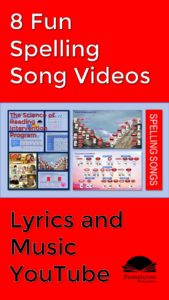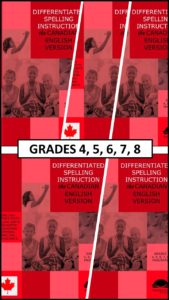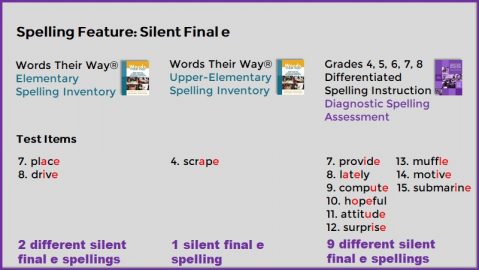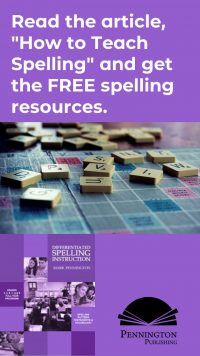In this article, teachers will learn how to how to diagnose and remediate the spelling pattern deficits of their individual students to help them “catch up while they keep up” with grade-level spelling instruction. To read my article about how to differentiate and individualize grade-level spelling instruction, click How to Teach Spelling. First, let’s forget what we have heard about older students who are poor spellers:
“Once a bad speller, always a bad speller”; “You can’t teach an old dog new spelling tricks”; “Einstein was a horrible speller”; “Spelling is only an editing skill”; “Now that we have spellcheck, spelling doesn’t matter.”
Reading research demonstrates that your students can learn what they’ve missed while they learn grade-level spelling rules and patterns. But, first you need to determine specifically what your students do and don’t know and how to fill any gaps in their spelling knowledge. Let’s not waste valuable instructional time re-teaching what they already know. Instead, use the Diagnostic Spelling Assessment to pinpoint exactly what they need to learn. I’ll provide a FREE download at the end of the article.

FREE Diagnostic Spelling Assessment
But, wait. Most of the teachers in my school use the Elementary Spelling Inventory found in Words Their Way. Isn’t that just as good?
In a word, “No.” The Elementary Spelling Inventory includes 25 words. The test is designed to indicate which developmental spelling stage each of your students has and has not yet mastered. Laying aside the theory of developmental spelling for our purposes (many notable spelling researchers including Louisa Moats and Richard Gentry dispute this theory), the individual test results only narrow down the spelling deficits to general stages. Knowing a student’s developmental spelling stage does not tell the teacher what to teach and what not to teach within that spelling stage.
In contrast, the Diagnostic Spelling Assessment provides that specificity. Reference the graphic to see examples of how much more teachable data is provided by the Diagnostic Spelling Assessment than that provided by the Elementary Spelling Inventory.
Yes, the Diagnostic Spelling Assessment takes a bit longer to administer and correct, because it tests all of the common spelling patterns. However, the included audio file makes administration simple. Total test administration time is less than 25 minutes.
- Grade 8 students complete words #s 1–102 to assess all kindergarten–seventh grade common spelling patterns.
- Grade 7 students complete words #s 1–98 to assess all kindergarten–sixth grade common spelling patterns.
- Grade 6 students complete words #s 1–89 to assess all kindergarten–fifth grade common spelling patterns.
- Grade 5 students complete words #s 1–79 to assess all kindergarten–fourth grade common spelling patterns.
- Grade 4 students complete words #s 1–64 to assess all kindergarten–third grade common spelling patterns.
The Diagnostic Spelling Assessment uses multisyllabic words to isolate the variable of sight word knowledge. The test is ordered according to the research-based instructional phonics sequences of instruction. After all, encoding (spelling) is the opposite side of the same coin as decoding (reading). Spelling and reading are mutually dependent and research is clear that good spellers and good readers tend to be good writers (Adams, 2011; Gentry & Graham, 2010; Moats, 2005; Reed, 2012).
How to Administer the Diagnostic Spelling Assessment
Preparation
Pass out binder paper and pencils. Model how to number the test items on the board and tell students to number accordingly.
Administration
I recommend using the audio file, which includes the test directions, spelling words, and example sentences. The test pacing is exactly timed to ensure proper and controlled testing. Additionally, make-up tests for absent or newly enrolled students is a simple task with the audio file.
However, some teachers prefer to read the directions and dictate the words and example sentences themselves.
Introduce the Diagnostic Spelling Assessment to students. Say—
“This is a test to see if you can accurately spell the words I say out loud. I will first say the spelling word; then repeat it; then use it in a sentence; and then repeat the spelling word once more. Listen carefully because I won’t repeat the words after the test is finished. Please print the spelling words.”
Don’t elongate the vowel or consonant sounds to emphasize spellings. Keep a consistent pace of about seven seconds per test item. Any longer and students will lose their place or begin daydreaming. Since this is a long test, teachers may elect to take a short stretch break in the middle of the test administration.
Grading
Grade the assessment, marking only the specified sound-spelling pattern for each word. In other words don’t mark the word wrong because of other spelling errors in the word. For example, if the sound-spelling pattern is Long /a/ “__ay” and the word is “payment,” the student spelling of “paiment” would be wrong, but “paymunt” would be right. This selective grading isolates the sound-spelling pattern problem areas for each student. I’ve found that instructional aides and parents are quite capable of accurately grading and recording the Diagnostic Spelling Assessment with minimal training.
Recording
The teacher, instructional aide, or parent charts the individual skills that your students have not yet mastered on the mastery matrices. Yes, these recording matrices are provided in your FREE download. Record a slash (/) for un-mastered skills, and leave the box blank for mastered skills. Make two copies of the matrices: one for student reference and one for teacher reference.
Post one set of the Diagnostic Spelling Assessment Mastery Matrices on a wall at the rear of the classroom for student reference. Note that teachers may choose to list students by identification number rather than by name on these matrices. Keep the teacher copy in a binder at your desk.
How to Remediate Spelling Pattern Deficits through Individualized Instruction
Each of the spelling test words corresponds to the Spelling Patterns Worksheets. Count and total the slashes (/) for each of the spelling patterns on the Diagnostic Spelling Assessment Mastery Matrices to determine how many of each Spelling Pattern Worksheets you will need to copy. Copy these worksheets and group them in separate numbered file folders.
The Spelling Pattern Worksheets are designed to help students master the previous grade-level Common Core Language Spelling Standards. Each worksheet lists the sound-spelling pattern focus, example words, a spelling sort, a rhyme or word search activity, word jumbles, a short writing application, and a sentence dictation formative assessment. Students progress at their own rates to master previous grade-level spelling patterns. Yes, sample Spelling Pattern Worksheets are included in your FREE download.
Let’s look at the individual instructional components. The format of the Spelling Patterns Worksheets is intentionally similar to promote independent student work. The spelling pattern is listed first and connects the sound to the spelling. For example, Spelling Pattern Worksheet #47 (numbers vary per program) lists: oo Sound as in woodpecker “_u_” and provides the FOCUS: The oo sound heard in woodpecker can b spelled “_u_” as in put. Notice that blanks are included in the spelling pattern. Each represents a missing sound-spelling. In this case, the “_u_” spelling is missing both beginning and ending consonant sounds. No syllable can be written as a consonant–u (oo sound). No syllable can be written as a u (oo sound)–consonant. Both consonants must be included to write a syllable. For example, put could be written as put to show the spelling pattern.
The next instructional component is the SORT section. Students use pronunciation, analogous spelling patterns, and the spelling marks and blanks to categorize the spelling pattern words. Notice how the Spelling Pattern Worksheet #47 sort provides the key components of the /ion/ spelling rule. Students are told the rule up front and apply the rule with the spelling variations. Unlike “other discovery sorts” in which the spelling rule must be learned inductively, don’t leave your students guessing! Teach and apply the explicit rule. Here a teacher might opt to have the student(s) listen to, practice, and memorize the /ion/ spelling rule with a little help from the “Ending /ion/ Rule” spelling song. The author’s grades 4, 5, 6, 7, and 8 Differentiated Spelling Instruction programs include conventional spelling rule songs and raps.
Students also complete a RHYME or BOOK SEARCH activity. For spelling patterns conducive to rhyming, such as the “aw” spelling pattern, four rhyming words which apply the /aw/ spelling are provided. For other non-rhyming spelling patterns, students use their sustained silent reading book or a class novel to write example words which use the focus spelling pattern with their corresponding page numbers.
Additionally, students complete four JUMBLE words, which include the focus spelling patterns. Students quickly discover that using the spelling pattern clues helps them unravel the jumbled words A multisyllabic Bonus JUMBLE is included. For example, in Spelling Worksheet #48, knowing the “al” spelling pattern helps students identify also; the “awl” spelling patterns helps identify drawl; the “aw” helps with pawn; and also helps with the Bonus jawbone.
Finally, the WRITE section requires students to apply the spelling patterns to additional words, not listed on the Spelling Pattern Worksheet. This spelling pattern application serves as the formative assessment to determine whether students have or have not yet mastered the individual spelling pattern.
Correction and Formative Assessment
After completing a Spelling Pattern Worksheet, the student self-corrects and self-edits with a different color pen or pencil from one of the Spelling Patterns Worksheets Answer Binders. I suggest making several of these binders and storing them in different parts of the classroom for student access. Tell students that they receive the same credit for completing a worksheet with errors and different color revisions with the correct answers as they do for completing a worksheet without errors. It’s the practice that’s important. This procedure eliminates the incentive to cheat. Note that no answers are provided for the WRITE formative assessment.
When finished correcting the worksheet, the student comes up to the teacher’s desk to mini-conference. If the student has self-corrected and self-edited the practice section and “passed” the WRITE formative assessment, change the slash (/) into an “X” for mastery on the appropriate box on the mastery matrix and record an A on the student’s worksheet. Convert the A to points, if you use a point system for grading. For example, 10 points for an A. Note that the teacher determines the level of mastery for each WRITE formative assessment.
If the student has not yet mastered the spelling pattern or patterns, you have two instructional options:
1. If the student understands the spelling pattern after the mini-conference, direct the student to re-do the WRITE formative assessment and return for re-correction.
2. Record a a √ instead of an A and direct the student to move on to the next worksheet. The student will have the chance to re-do the worksheet after completing the rest of their assigned worksheets. Award half-credit, say 5 points, for a √.
Here are a few Helpful Hints to ensure instructional success.
Tell students to begin with the lower numbered Spelling Pattern Worksheets and to complete only those worksheets indicated by slashes (/). Tell them that they won’t receive credit for completing worksheets without slashes because they have already mastered those spelling patterns.
After a student has mastered a Spelling Pattern Worksheet, direct him or her to change the slash (/) into an X for mastery on the appropriate box on the matrix. Using pencil of course. Filling in the X gives students a sense of accomplishment and motivates students to complete additional work. Don’t forget to mark the X in your teacher binder, as well.
Set an expectation as to how many Spelling Pattern Worksheets must be completed per week. Teachers may choose to have students and/or parents set specific goals. Monitor student progress and adjust expectations as needed. Worksheets may be completed in class or for homework.
Maintain a productive work environment by managing time. Limit the mini-conference to no more than 30 seconds. The focus should be on the WRITE formative assessment, not the rest of the worksheet. Also, manage crowd control by limiting the length of your mini-conference line to three students. Waiting students can sign up for their places in line on the board and then work on their next worksheet until their turn arrives to conference. Finally, establish group norms regarding talking, helping peers, and work ethic.
Want to see how to use the Diagnostic Spelling Assessment and Spelling Pattern Worksheets? Check out this four-minute video!
_______________________________________

Grades 4-8 Spelling Programs
Differentiated Spelling Instruction is a complete grade level spelling program built upon conventional spelling rules and developmental spelling patterns. Five programs are available: Grade 4, 5, 6, 7, and 8. This digital download (eBook) program includes all resources teachers need to individualize instruction. Developing a weekly spelling plan that differentiates instruction for all of your students is a challenging task for even the best veteran teacher, but help has arrived! There is no better spelling program for your grade level students, GATE students, special ed, ESL/ELD, and below grade level students. Perfect for RtI.
Plus, get the Diagnostic Spelling Assessment and the targeted spelling pattern worksheets you need to remediate previous grade level spelling deficits for all your students. Now that’s effective differentiated and individualized instruction! Your students can catch up, while they keep up with grade level spelling instruction. You’ll also appreciate the helpful resources in the appendix, including how to study spelling tips, spelling proofreading, word lists, spelling rule memory songs (Mp3s), and spelling review games.
The program is easy to teach. We even provide two quick YouTube training videos to ensure your success!
Get the Diagnostic Spelling Assessment, Mastery Matrix, and Sample Lessons FREE Resource:

Grammar/Mechanics
differentiated spelling instruction, English spelling, grade 4 spelling, grade 5 spelling, grade 6 spelling, grade 7 spelling, grade 8 spelling, Mark Pennington, spelling assessment, spelling lists, spelling program, spelling rules, spelling sorts, spelling tests, spelling word lists, spelling workbook, spelling worksheet, weekly spelling lists

 Introducing the
Introducing the 















